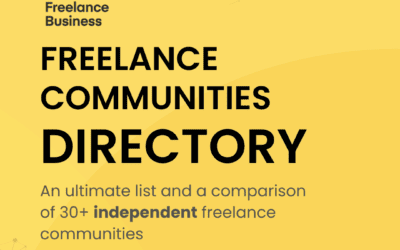A significant proportion of freelancers doing location-independent work are considering the idea of becoming digital nomads. The excitement of exploring new cities and the sense of freedom that comes with traveling capture the imagination of many. If you’re a travel lover who wants to turn dreaming into action and become a digital nomad yourself, you can learn the 7 steps below.
Who are digital nomads?
First, let’s be clear about what exactly we mean by digital nomads. Digital nomads move frequently and work while traveling. They keep in touch with their customers digitally. All they need to work is a computer with internet access and possibly some other equipment like a camera.
Digital nomads can be freelancers, entrepreneurs running their own businesses, as well as remote employees. Read our article for more clarity about the difference between these terms.
Not all location-independent workers are digital nomads though. Even if they choose to travel, some have a permanent base, a home to return to after major trips. For digital nomads, on the other hand, traveling is a lifestyle. They may spend several months in a country or city, but they are almost constantly on the move. They are attracted to discovering new places, cultures and people.
How can you become a digital nomad?
Step 1: Go freelance!
Since you are reading this article, you are probably considering yourself a freelancer, so you can probably tick the first step off your to-do list.
If you’re already a freelancer doing freelance work, you’re just a hair’s breadth away from taking action and joining the growing tribe of digital nomads.
If you’re still in touch with your clients face-to-face, it’s worth going fully digital bit by bit. If you work in IT, as a marketeer, consultant or content producer, here’s some good news. You’ve got a winning case – in these fields, you’ll almost certainly be able to work as a digital nomad.
Tip: On Go Overseas, you’ll find a summary of the most typical digital nomad jobs.
Tip: You can not only be a digital nomad as a freelancer, if you work for a flexible enough company, you can also choose to work from different locations.
Step 2: Minimise your costs.
To maintain a digital nomad lifestyle you need to rein in your spending. You will need to finance travel, accommodation and everyday expenses in different countries. You also need to think about unexpected expenses. For example, you may suddenly need medical treatment that will cost you a lot. Insurance services like SafetyWing can help you not only save on medical expenses, but avoid the headache of dealing with local health services by taking care of the process for you.
Before you travel, build up an emergency reserve (most people recommend at least six months of living expenses). And make sure you have adequate health insurance.
What you should expect to pay depends largely on the city or country you choose. Read the Full time nomad article to help you plan.
Step 3: Embrace a minimalist approach.
When traveling, you are limited in how much stuff you can take with you. Start eliminating your dependence on things. Prioritize quality over quantity. Think about what items are essential for you and what consumables you can buy locally (such as skin care, sanitary or body cleaning products).
For a summary on how you can benefit from minimalism as a digital nomad, see the article on Become Nomad.
Tip: Get inspiration from other digital nomads on how they pack. Check out Pack Hacker or Nomadic Memoir for examples, but here are some great tips from Fanni:
Fanni Fridrich is an experienced social media expert who was one of the first in Hungary to tap into the potential of TikTok. Fanni’s advice for digital nomad beginners:
- Don’t take anything with you that is in the “I might need it” category. These things will not be needed 99% of the time or can be purchased locally.
- Check other nomads’ reviews of a place on Nomadlist before you book. Check the speed of the internet in particular.
- When jumping from country to country, always allow yourself a few days to adjust to the new place and don’t put important meetings and deadlines on those days. You never know what’s going to happen at the airport or in your stomach…
Step 4: Prepare yourself for flexible working.
As a digital nomad, you need to pay even more attention to how you schedule your work. As well as visiting cities and exploring new places, you need to be able to complete your tasks efficiently.
Start using time management software (e.g. Toggl Tracker, Calendly), task management systems (e.g. Trello, Asana) and professional, transparent communication channels (e.g. Slack, Zapier) before you leave. See our suggestions in the 80+ tools for freelancers article here.
Tip: Instead of beachside hammocks, digital nomads actually work mostly in coffee shops and coworking offices. You can try out how effectively you can work in such places before you leave.
If you have online meetings and are in a different time zone, you can see how much time difference you have with your partner here.
Maryna Kotenko was born and raised in Ukraine, but currently works remotely and travels worldwide. Her expertise is in business development & social media management. These are the 3 biggest challenges she faced with when she started her digital nomad lifestyle:
Challenge #1: Time management, as you could be torn between responsibilities at work and the desire to explore new places.
Challenge # 2: A workplace. Setting up a comfortable workplace could be challenging, regardless of what option you’ll choose: your apartment, coffee shops or coworking.
Challenge # 3: Internet. Finding a stable internet connection (and not the most expensive one) will always be a priority. So before you go to the country, region or city you’re thinking about, check the internet. For some countries, this could be a real issue.
Step 5: Plan your first destination.
Where you first set foot can be influenced by many things. From your language skills to your budget and local conditions (e.g. internet and public safety).
During your trip, you may want to join local digital nomad communities. The Nomadlist will help you with this, and with choosing your location. The platform will give you all the information you need about your destination: you can even find out about the most popular ones.
Tip: Get first-hand information. Follow digital nomads and get useful information from their content. Not sure where to start? Check out Anyplace’s list of 28 digital nomad bloggers and influencers.
Fanni suggests 3 places to start:
1. For the first few months, I think you should stay on the continent where you live anyway. It’s already quite a change of lifestyle, so it’s good to be able to hang on to at least a few familiar shops and foods.
2. My second suggestion is Peru. It’s very different there, but the kindness and openness of the people completely makes up for it, so it’s not too much of a shock as a beginner. The food is brilliant, and it’s easy to get cheap accommodation. You can also visit places of wonders such as Machu Picchu, Aguas Calientes or even Huacachina Oasis.
3. The third is not a usual suggestion. I think the US, although more expensive, is worth it. It’s full of beautiful national parks and if you want, you can start your morning on an ocean beach and your evening in the mountains or in a cabin. If you leave the tourist spots behind and want to see real American life, there are endless activities and accommodation options. And from a networking point of view, it doesn’t end there. I’d also point out that English is more comfortable for many people, so you don’t immediately start in a country where you just hope to speak to someone. My favourite place was Savannah in Georgia, which is supposed to be the most ghostly place in the country.
Step 6: Find out about local specificities.
If you are planning to stay in a country for a short time, a tourist visa is usually sufficient, but for stays of more than 90 days, special conditions apply in most cases. Thanks to the rise of atypical forms of employment, more and more places are offering visas specifically for freelancers and digital nomads. So, if you are planning a longer stay, it’s worth looking into these.
Step 7: Are you ready? Put your shoes on and head out into the world!
The digital nomad lifestyle, for all its glamour, has its challenges. So it’s not a good idea to take the plunge without thinking it through. However, with careful preparation, this daring lifestyle can not only provide you with a wealth of experiences, but also give you the flexibility and resilience to succeed in any walk of life.
To get started, it certainly doesn’t hurt to join the Freelance Business Community Slack community, where you can connect with freelancers, entrepreneurs and digital nomads from all around the world!




